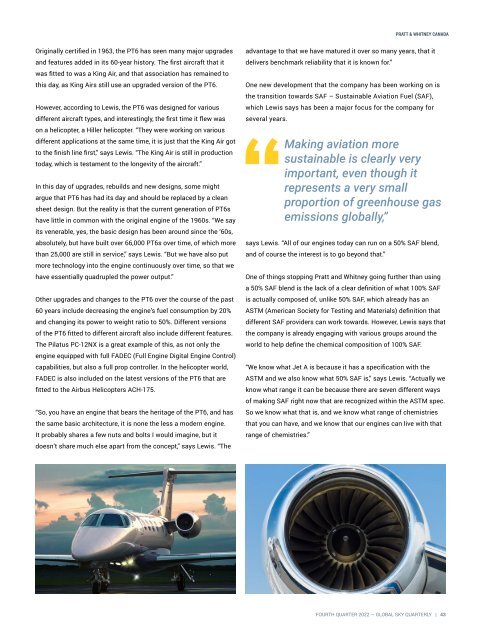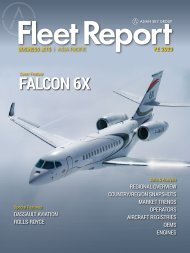Asian Sky Quarterly 2022 Q4
Create successful ePaper yourself
Turn your PDF publications into a flip-book with our unique Google optimized e-Paper software.
PRATT & WHITNEY CANADA<br />
Originally certified in 1963, the PT6 has seen many major upgrades<br />
and features added in its 60-year history. The first aircraft that it<br />
was fitted to was a King Air, and that association has remained to<br />
this day, as King Airs still use an upgraded version of the PT6.<br />
However, according to Lewis, the PT6 was designed for various<br />
different aircraft types, and interestingly, the first time it flew was<br />
on a helicopter, a Hiller helicopter. “They were working on various<br />
different applications at the same time, it is just that the King Air got<br />
to the finish line first,” says Lewis. “The King Air is still in production<br />
today, which is testament to the longevity of the aircraft.”<br />
In this day of upgrades, rebuilds and new designs, some might<br />
argue that PT6 has had its day and should be replaced by a clean<br />
sheet design. But the reality is that the current generation of PT6s<br />
have little in common with the original engine of the 1960s. “We say<br />
its venerable, yes, the basic design has been around since the ‘60s,<br />
absolutely, but have built over 66,000 PT6s over time, of which more<br />
than 25,000 are still in service,” says Lewis. “But we have also put<br />
more technology into the engine continuously over time, so that we<br />
have essentially quadrupled the power output.”<br />
Other upgrades and changes to the PT6 over the course of the past<br />
60 years include decreasing the engine’s fuel consumption by 20%<br />
and changing its power to weight ratio to 50%. Different versions<br />
of the PT6 fitted to different aircraft also include different features.<br />
The Pilatus PC-12NX is a great example of this, as not only the<br />
engine equipped with full FADEC (Full Engine Digital Engine Control)<br />
capabilities, but also a full prop controller. In the helicopter world,<br />
FADEC is also included on the latest versions of the PT6 that are<br />
fitted to the Airbus Helicopters ACH-175.<br />
“So, you have an engine that bears the heritage of the PT6, and has<br />
the same basic architecture, it is none the less a modern engine.<br />
It probably shares a few nuts and bolts I would imagine, but it<br />
doesn’t share much else apart from the concept,” says Lewis. “The<br />
advantage to that we have matured it over so many years, that it<br />
delivers benchmark reliability that it is known for.”<br />
One new development that the company has been working on is<br />
the transition towards SAF – Sustainable Aviation Fuel (SAF),<br />
which Lewis says has been a major focus for the company for<br />
several years.<br />
says Lewis. “All of our engines today can run on a 50% SAF blend,<br />
and of course the interest is to go beyond that.”<br />
One of things stopping Pratt and Whitney going further than using<br />
a 50% SAF blend is the lack of a clear definition of what 100% SAF<br />
is actually composed of, unlike 50% SAF, which already has an<br />
ASTM (American Society for Testing and Materials) definition that<br />
different SAF providers can work towards. However, Lewis says that<br />
the company is already engaging with various groups around the<br />
world to help define the chemical composition of 100% SAF.<br />
“We know what Jet A is because it has a specification with the<br />
ASTM and we also know what 50% SAF is,” says Lewis. “Actually we<br />
know what range it can be because there are seven different ways<br />
of making SAF right now that are recognized within the ASTM spec.<br />
So we know what that is, and we know what range of chemistries<br />
that you can have, and we know that our engines can live with that<br />
range of chemistries.”<br />
Making aviation more<br />
sustainable is clearly very<br />
important, even though it<br />
represents a very small<br />
proportion of greenhouse gas<br />
emissions globally,”<br />
FOURTH QUARTER <strong>2022</strong> — GLOBAL SKY QUARTERLY | 43
















